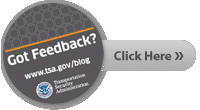
The internet, as I am sure you all would agree, is a marvelous thing. People from coast to coast and around the world have used it for everything… researching term papers, reading the news, paying bills and even writing blogs. The internet is also a marvelous tool for those looking to save or spend money.
These tough economic times have led many passengers to search for discount flights on the Internet and even, as we have learned at TSA, used the Internet to learn to make homemade gadgets. It’s these gadgets that have caused some …. How shall we say, second and third looks at the checkpoint. By second and third looks I’m not talking about just TSA, I’m talking our Bomb Appraisal Officers (BAO) and local bomb squads.
In a matter of minutes this morning,
Blogger Bob found Internet sites with “how to build” instructions for a
desulfator and
radio receiver in a common mint tin (a desulfator is used to put high voltage pulses into a battery), a
guitar amp out of a cigarette pack, a
mint tin made into a guitar and a
circuit bender made from an old plastic parts kit. While none of these items are threatening in and of themselves, imagine what a mint tin with wires, batteries and a switch looks like in an x-ray machine.
While each of these items gets the award for creativity, it might be a good idea to put these items in your checked baggage or maybe even leave them at home. However, if you have to bring them with you, maybe letting our folks know that you are the master innovator could prevent any unnecessary surprises from occurring. Nonetheless, expect some extra scrutiny…
What do I mean by further scrutiny? Yesterday, March 24, an item very similar to those described above, was blown into a zillion pieces in Palm Springs, California, because neither our officers, our BAO or the local bomb squad could determine with 100% certainty the item didn’t pose a threat after seeing it on the x-ray.

So, if you are traveling with a homemade charger, amp, desulfator or anything with batteries, screws and wires sticking out of it that could be deemed out of the ordinary, please tell us. It will probably allow us and the local bomb squad to help keep your items in one piece, not a zillion. Probably…
Nico
EoS Blog Team
Clarification Update: 03.26.2009 1137
Based on the comments, Nico & I felt a clarification was needed. This post purposely never mentioned a passenger because the bag was left unattended and there was no passenger available to interview. We're not implying that you cannot travel with these types of items, we're just pointing out that they could be of concern, or possibly even hold you up a little bit. Listen, we think these things are cool too, but this is just a friendly "heads up" and not a threat.
Also, explosive detection systems would not identify these types of items in checked baggage, because they aren't explosives. Our checked baggage machines use CT technology and can actually recognize and alarm on potential explosives.
Bob
EoS Blog Team
Labels: mission, technology, weird



 If you are concerned or uncomfortable about going through the walk-through metal detector or Mill with your insulin pump, notify the TSO that you are wearing an insulin pump and would like a full-body pat-down and a visual inspection of your pump instead. Advise the Security Officer that the insulin pump cannot be removed because it is inserted with a catheter (needle) under the skin.
If you are concerned or uncomfortable about going through the walk-through metal detector or Mill with your insulin pump, notify the TSO that you are wearing an insulin pump and would like a full-body pat-down and a visual inspection of your pump instead. Advise the Security Officer that the insulin pump cannot be removed because it is inserted with a catheter (needle) under the skin.




